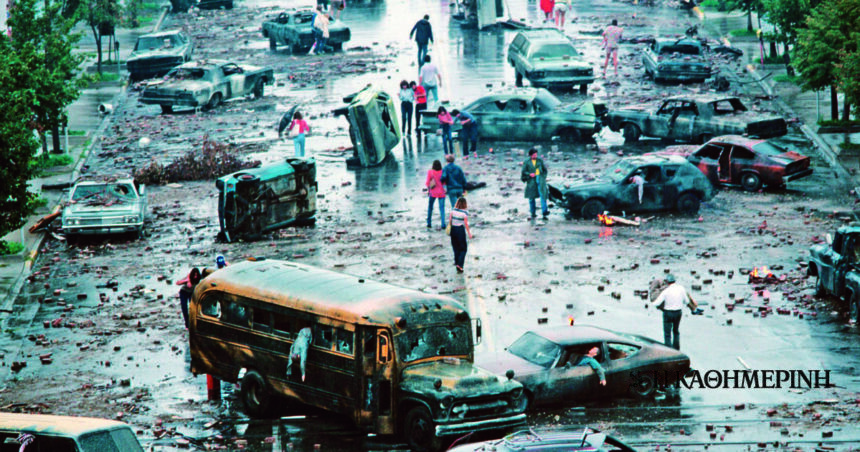In the spring of 1983 the director Nicholas Meyer he was sitting on hot coals. More than a year of intensive work was in danger of going awry, since the top executives of the network ABCwhich had ordered his last filmthey were very strongly considering putting it on the “shelf” before it was even finished. Rumors even said that the president himself Reagan he would rather the film never reach television sets. Not that Meyer didn’t expect it. “The next day” was a film intended to illustrate in relief what would happen in the event that the USA they were facing a large-scale nuclear attack on their soil – not today, but at a time when o Cold war and the nightmare of a nuclear holocaust were very much alive.
Eventually, thanks to Meyer’s inspired move-insurance policy of handing out even unfinished copies to certain industry executives and anti-nuclear activists, the film was screened in November of that year. It is estimated that over 100 million Americans watched its premiere. President Reagan wrote in his diary that the viewing experience caused him to revise some of his views on nuclear weapons policy. Four decades later, with relations between Russia and the West again at war, it seems crucial to remember the message of this shocking film, which may bear the somewhat unfair label of “television”, but is a clear example of top anti-war cinema, which it is largely missing from our days.

An impending disaster
The action basically unfolds in state of missouriin its wider area Kansas Citywhere we are introduced to a series of characters: a middle-aged doctor sees his young daughter leave following her lover. A farming family prepares to marry off their own daughter. A low-ranking air force officer vows to change careers in order to spend more time with his family. For at least an hour the viewer watches these images of peaceful life, around baseball fields, vast farms and the local university. Ominous signs, however, are everywhere, as television, radio and emergency editions of newspapers broadcast escalating hostilities on the border between Eastern and West Berlin. The Soviets invade the West Germany. Suddenly the news is circulating that Moscow is being evacuated. This can only mean one thing. The residents of Kansas City, who know that their area is home to at least 130 silos with nuclear missiles, are trying to leave it by any means. Most, however, do not make it.

Nicholas Meyer’s film consistently conveys the message that a conflict with nuclear weapons has no winners and losers.

The cinematic mastery of Nicholas Meyer, but also of the screenwriter David Humeit basically lies in the way they “time” their film between before and after the disaster. As Missourians frantically rush to streets and supermarkets for supplies, only to descend immediately into (whatever) shelters, silos around them open and rockets are launched. Now there is no doubt; if their own nukes are in the air then the adversaries are also traveling towards them. This terrifying realization is riveting, in addition to the protagonists and the viewer himself – it is perhaps the most nightmarish moment of the entire film.
The common man’s perspective
Besides, we don’t have more information than they do. “The Day After” is not at all concerned with big decisions, tense military councils and war proclamations. No politicians or senior officers are ever shown on screen. It’s not even (on purpose) made clear who pushed the nuclear doom ‘button’ first, which was one of the many areas of conflict during production planning. Because all of this means virtually nothing to the people of Missouri, in whose shoes the film’s creators want us to imagine. It is the lives of these people that disappear, as the huge nuclear “mushrooms” are rising on American soil. The ground-breaking special effects used by Meyer and his collaborators may seem somewhat primitive today, but the images of people being wasted or burned alive and entire cities being leveled certainly leave an impression on the viewer. In the original editing of the film, there were significantly more such scenes, but they were deleted in order not to overburden the family audience to whom they were directed.

But it is not only the human perspective of “The Next Day” that sets it apart, but also its non-propaganda character. In a cinematic decade, where o James Bond of Roger Moore executes Soviet agents in East Berlin (“Octopussy») and o John Rambo of Sylvester Stallone decimates entire armies of America’s enemies in Vietnam and AfghanistanNicholas Meyer’s film consistently conveys the message that such a conflict has no winners and losers. “Do you think we’re going to dig out the holes, cover them with dirt and build a supermarket on top? We’ve known about the bombs for 40 years, but we didn’t really care,” says a pregnant woman to the doctor, played by Jason Robards. The two-time Academy Award-winning American actor (and decorated World War II veteran) was the film’s only real star. Meyer did not want many of these, despite the large budget available to him, since he believed that their presence would be more reminiscent of typical Cold War disaster movies. Eventually he and his collaborators cast several relatively unknown actors whose characteristics matched the Midwesterners they were portraying. In addition, almost all of the (too many) silent roles in the film were played by residents of the wider area of Lawrence, Kansaswhere the filming took place.
Edited by: Evanthis Chatzivasiliou




